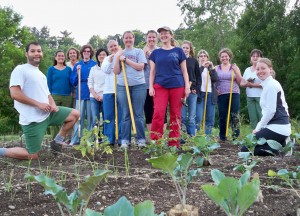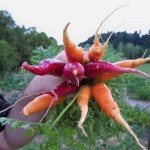By Jess Hyman
 Jess Hyman is Executive Director of the Vermont Community Garden Network, which works with community and school garden groups throughout Vermont. We asked her to share her thoughts about how food security and just food systems are grounded in self-production.
Jess Hyman is Executive Director of the Vermont Community Garden Network, which works with community and school garden groups throughout Vermont. We asked her to share her thoughts about how food security and just food systems are grounded in self-production.
Discussions about food systems and the working landscape in Vermont are rooted in our agricultural tradition and the closely related issues of hunger and obesity. However, these discussions often focus on market development and overlook the important role that self-production can play in meeting food needs. For example, the recent “Local Food for Healthy Communities” report from the Vermont Community Foundation (VCF) does an excellent job of outlining the statewide issue of food security and highlights many of the effective and innovative strategies to bring fresh, healthy food to all Vermonters. Geared toward philanthropists, the report focuses on three components of the food system – farmers, institutions, and Vermont consumers – as the main drivers of change.
This approach should also recognize the role of self-production – growing food for ourselves, our families and our neighbors – as a way to move us closer to a healthier and more equitable food system. This critical piece of the conversation often missing in statewide and regional food systems discussions, likely because the scale of production is considered relatively small compared to commercial production.
 But it’s not just about the food itself. Growing our own is proven to have positive impacts far beyond the pounds of food. Vermont’s 300+ community and school gardens produce fresh, affordable, healthy food for thousands of people of all ages and backgrounds. In addition, by connecting neighbors, building healthy soil, and teaching food production, community and school gardens play a key role in growing strong and resilient communities. According to this year’s UVM Center for Rural Studies Vermonter Poll, 16% of Vermonters get some food from a community garden. These abundant food production sites are managed by dedicated gardeners, local volunteers, and passionate nonprofit, municipal, and school staff. They need support as they work to meet the needs of their communities.
But it’s not just about the food itself. Growing our own is proven to have positive impacts far beyond the pounds of food. Vermont’s 300+ community and school gardens produce fresh, affordable, healthy food for thousands of people of all ages and backgrounds. In addition, by connecting neighbors, building healthy soil, and teaching food production, community and school gardens play a key role in growing strong and resilient communities. According to this year’s UVM Center for Rural Studies Vermonter Poll, 16% of Vermonters get some food from a community garden. These abundant food production sites are managed by dedicated gardeners, local volunteers, and passionate nonprofit, municipal, and school staff. They need support as they work to meet the needs of their communities.
Food grown in home, community and school gardens goes directly onto family tables and school lunch trays. But the impact goes far beyond these fresh vegetables and fruit, which represent just a small percentage of the total food consumed. Learning about where food comes from and taking part in growing and sharing it is proven to fundamentally change how youth and adults experience, choose, and value food. Studies show that learning to grow our own food positively influences lifestyle and purchasing decisions and enhances appreciation for the environment, farmers, and the greater food system.
 As noted in the VCF report, getting more fresh local food into school, institutions, and local markets – and making sure that everyone can afford, access, and cook it – is of utmost importance. And we can’t lose sight of hands-on food education. Gardens at schools and institutions, in neighborhoods, and at workplaces, provide an immediate connection to where food comes from and create safe places for people to grow and learn together. Evidence shows that growing food at a small scale is the first step to making healthier food choices overall.
As noted in the VCF report, getting more fresh local food into school, institutions, and local markets – and making sure that everyone can afford, access, and cook it – is of utmost importance. And we can’t lose sight of hands-on food education. Gardens at schools and institutions, in neighborhoods, and at workplaces, provide an immediate connection to where food comes from and create safe places for people to grow and learn together. Evidence shows that growing food at a small scale is the first step to making healthier food choices overall.
For food system change to truly benefit all Vermonters, we need to make a fundamental change in the way we understand and value food. It’s not just all about the food we buy and put in our schools and institutions – it’s about the food we grow and what we learn in the process.










